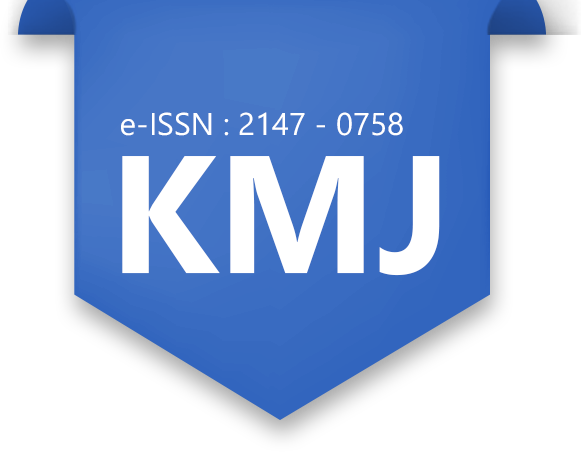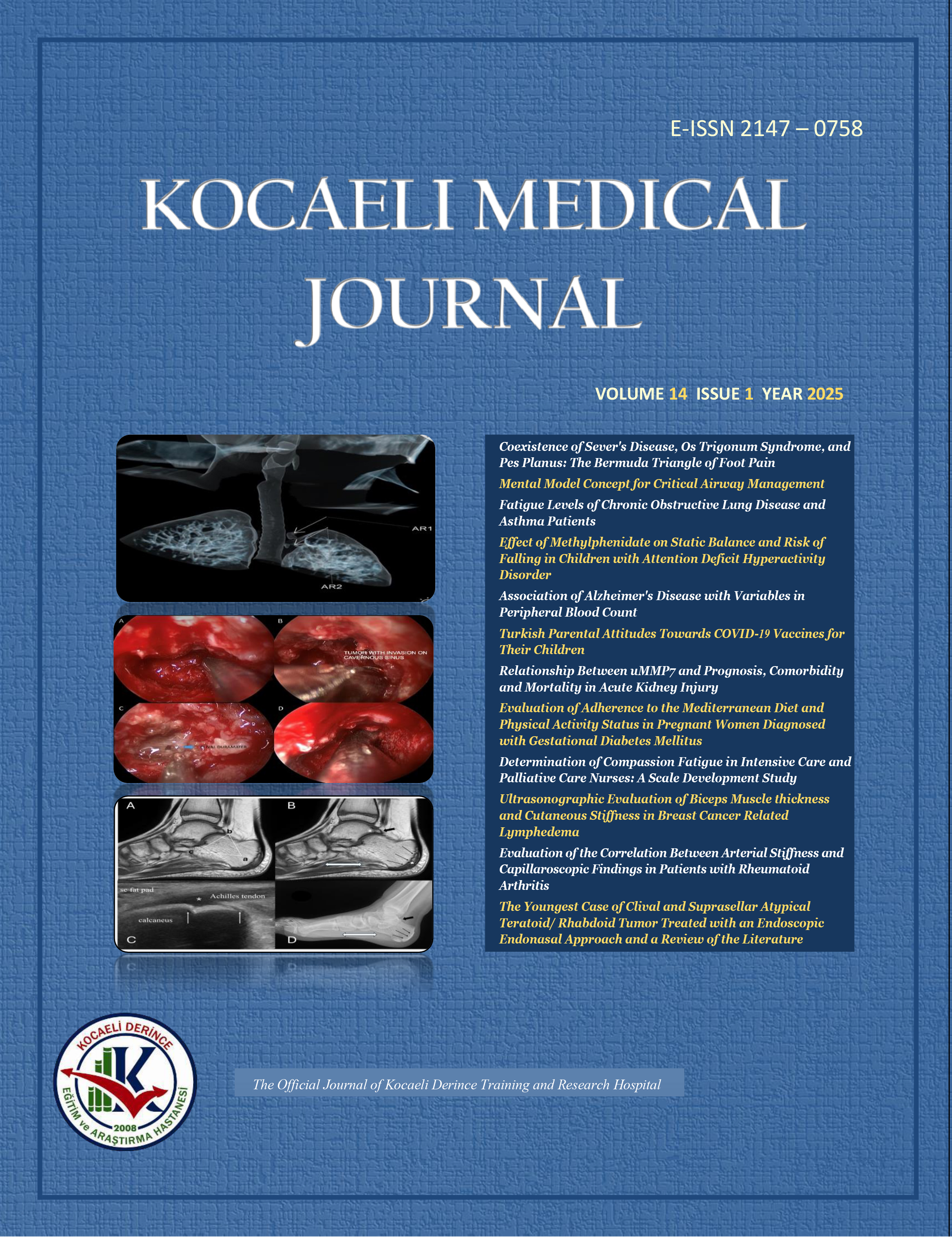
Volume: 1 Issue: 3 - 2012
| 1. | Medical Journal of Kocaeli Page I |
| ORIGINAL ARTICLE | |
| 2. | Lower Gastrointestinal Endoscopy Results: Region of Ağrı Doğubayazıt Mustafa Şit, Gülali Aktaş, Edip Erdal Yılmaz Pages 1 - 4 OBJECTIVE: Endoscopic examination, which is the gold standard in diagnosis and treatment of mucosal pathologies in lower gastrointestinal system, is widely used. METHODS: 736 patients with lower gastrointestinal endoscopy were included in the study. RESULTS: The most colonoscopic pathologies were hemorrhoids and polyps. CONCLUSION: Endoscopy is the gold standard technique for detecting benign and malign colonic pathologies. In addition, endoscopy is beneficial determining the pathologies caused by Enterobius Vermicularis and environmental factors. |
| 3. | The comparison of tecniques of different sedo-analgesia in the outpatient gynaecologic operations Abdulkadir İskender, Mesut Erbaş, İbrahim Karagöz Pages 5 - 10 OBJECTIVE: In general short-term gynaecological operations are performed under sedo-analgesia. In our study, we aimed to compare the effects of propofol, etomidate and ketamine which are frequently used for sedoanalgesia in short-term procedures. METHODS: 75 patients with age between 25-50 and operation risk of ASA I-II were included. Within 30 minutes before the operation, patients were premedicated with midazolam 0,04 mg/kg. Sedo-analgesia was performed with propofol 0,5 mg/kg in group P, with etomidate 0,1 mg/kg in group E and with ketamine 0,5 mg/kg in group K. Ramsay sedation scale, awakening time, time to being transferred to PACU, additional doses, total doses and side effects were recorded. RESULTS: In group P 60% of patients had apnoe, 13,3% had hypotension, 33,3% had bradycardia, 33,3% had pain in injection area. In group E, 6,7% of patients had apnoe, 40% had vomiting, 33,3% had myoclonic movements. In group K, 6,7% of patients had myoclonic movements, 13,3% had vomiting. CONCLUSION: Etomidate-alfentanyl combination was upper when compared with other groups in faster and simplified awakening. In addition to that, we sustaine that additional diseases of patients must be taken in the consideration to make a better drug-combination choice. |
| 4. | The Comparison The Effect of LMA Appliance After VIMA and TIVA Induction On Respiratuar Functions In Arthroscopic Procedures Selin Yavuz, İbrahim Karagöz, İlknur Suidiye Şeker, Gülbin Sezen Pages 11 - 17 OBJECTIVE: In this study, our purpose was to compare the effect of LMA appliance after VIMA or TIVA induction on respiratory functions in arthroscopic procedures. METHODS: The study was performed in operating room and polyclinic on pulmonary disease in Medical Faculty Hospital of the University of Duzce. Fifty patients, who were undergoing arthroscopic surgery under general anesthesia between ages 18-60 and classified as ASA I-II were including after they informed consent was taken. In the operation room ECG, systolic, diastolic and mean blood pressure, heart rate and peripheric oxygen saturation were monitorised. Respiratory function test was performed to all patient included, preoperatively, on 2nd hour postoperatively and on 24nd hour postoperatively in the sitting position, after defined how the test works. The test was performed 3 times each and the highest FVC and FEV1 values were selected. RESULTS: FEV1, FVC, and FEF %25-75 values postoperatively were significant lower than the values preoperatively and by discharge, but between FEV1, FVC, FEF %25-75 values preoperatively and by discharge were no significant difference. Additionally, FEV1 and FVC values in group VIMA were significantly lower than in group TIVA on every 3 test periods. FEV1/FVC values were not significantly different between two anesthesia groups. In addition to that, there was no significantly different between test periods preoperatively, postoperatively and by discharge. CONCLUSION: In conclusion, we determined by each two anesthesia groups that respiratory parameters like FEV1, FVC, and FEF %25-75 were decreased. By each two anesthesia groups were lung functions decreased and FEV1/FVC values remained. More studies on lung functions by different anesthesia techniques are needed. |
| 5. | The mortality of the neonates undergoing surgery: A series of 275 cases from a single-center Muazez Çevik, Aynur Açar, Mehmet Emin Boleken Pages 18 - 22 OBJECTIVE: Background: The surgical interventions performed by the pediatric surgeons during the neonatal period are usually life-saving. The aim of this study is to evaluate the factors those may have influence on the mortality of the newborns who required surgical intervention. METHODS: Patients and Methods: The hospital records of 275 pediatric patients ( age ≤ 1 month), who were opereated during newborn period by two pediatric surgeons between December 2008 and November 2012, were reviewed retrospectively. RESULTS: Results: Among the 275 neonates underwent 341 operations. The average of weights of the patients were 2508.24 ± 786.82 (950-5500) grams. One-hundred-fifty-six patients (56.7%) were male. The esophageal atresi was the most frequent abnormality (22.9 %, n=63). Sixty-one patients, and (22.5 % n=62) patients had anal atresia. The average time of hospital stay was 10.15±9.97 (1-62) days. The overall mortality rate was 25.1%. CONCLUSION: Conclusion: Surgical procedures can be life-saving in the neonatal period even if the risks related to the newborns are well determined and prevented. Thus, survival rates of the newborns those undergone surgery can be increased. |
| 6. | The Relationship Between The Level Of Nutritional Eduction And Clinical And Laboratory Findings In Hemodialysis Patients Ayşen Elmas, Elmas Erbay Saral, Arzu Tuğrul, Erkan Şengül, Fatih Bünül Pages 23 - 26 OBJECTIVE: The aim of this study was to assess the effect of nutritional eduction level on clinical and laboratory findings in hemodialysis patients. METHODS: The study group consisted of 65 patients (31 female, 34 male), undergoing routine hemodialysis. The mean age was 58.01 ±14.25 years. The most common etiology of chronic kidney disease was hypertension (%45). The nutritional education level was asssessed by using a survey sheet. Furtheremore, their demographic features, laboratory findings, blood pressure, and medications were obtained from their medical records. SPSS version 17.0 was used to perform the statistical analysis. P<0.05 was accepted to be significant. RESULTS: It has been found that the nutritional education was given to 59% of patients (n=38), but not 41% (n=27). Clinical and laboratory results were not different between the patients with and without education except for albumin and calcium level (p=0.04 and p=0,04, respectively). The education level in 80% of patients was primary school or unschooled. The family support was not present in 65% of patients. In analysis of the survey sheet, it has been established that the nutritional education level was not sufficient in patients receiving education. CONCLUSION: We showed that our patients could not understand, remember, or follow the nutritional education given them, along with a low education level and unsufficient family support. We suggest that the nutritional education should be given to patients regularly using by effective methods and that individual differences of patients should be taken into consideration during the educational period. |
| CASE REPORT | |
| 7. | Pulmonary embolism be caused by deep venous thrombosis after coronary artery bypass grafting İbrahim Kara, Yasin Ay, Cemalettin Aydın, Nuray Kahraman Ay, Tekin Yıldırım Pages 27 - 30 Deep venous thrombosis and pulmonary embolism are rarely mensioned as complications of coronary bypass surgery and carry high risk of morbidity and mortality. Although accurate diagnosis and rapid treatment are crucial to a successful outcome, there is no standart treatment option. Thrombolytic therapy, catheter embolectomy and open pulmonary embolectomy are the usual treatment options. This report describes our use of thrombolytic therapy and as an effective therapeutic approach in a case of massive pulmonary embolism that occured after coronary artery bypass grafting. |
| 8. | Uterus Didelphys with Unilateral Blind Hemivagina and Ipsilateral Renal Agenesis: Report of two cases Hakan Nazik, Murat Api, Meltem Aksu, Şule Gül Pages 31 - 34 Uterus didelphys with blind hemivagina and ipsilateral renal agenesis is a very rare anomaly and may be found in a female with normal menstrual periods.We report two cases with a double uterus, unilateral vaginal obstruction and ipsilateral renal agenesis. Both of the patients were virgin and their common clinical presentation was that of the onset of pelvic pain and dysmenorrhea, in association with the presence of a pelvic mass. In both of the patients we accurate the diagnosis by the laparotomic approach. A greater awareness of this syndrome should lead to accurate diagnosis and excision of the obstructing vaginal septum offers a complete relief of symptoms while preserving reproductive capacity. |
| 9. | A rare complication of perforated appendicitis: Scrotal abscess Turan Yıldız, Mehmet Arpacık, İbrahim Nuvit Tahtalı Pages 35 - 37 Infectious complications following perforated appendectomy are the most common. Intraabdominal abscess formation, pelvic abscess and wound infection are the most common sites of infection. Scrotal abscess following perforated appendectomy is very rare. The appropriate approach of perforated appendicitis with inguinal pathology is still controversial. We report an extremely rare case of an abscess that developed in the hydrocele sac after surgery for perforated appendicitis, in this study. |
| 10. | Microvascular Decompression of the Cochleovestibular Nerve for Tinnitus Mete İşeri, Selçuk Uçar, Arif Ulubil, Kenan Koç Pages 38 - 41 Neurovascular compression syndrome of cochleovestibular complex is manifested by tinnitus, vertigo, and hearing loss. The cochleovestibular nerve is compressed by the anterior cerebral artery at the entry or within the internal acoustic canal. Surgery by microvascular decompression is the preferred treatment. In this article, a patient with cochleovestibular nerve vascular compression treated by microvascular decompression is reported. |
| 11. | Heterotopic liver tissue on the gallbladder wall: A case report Heterotopic liver tissue Selim Sözen, Seyfi Emir, Cengizhan Şan Özdemir Pages 42 - 45 Ectopic liver is a rare developmental anomaly. Ectopic liver tissue can occur in several different organs such as the diaphragm, hepatic ligaments, omentum, stomach, retroperitoneum and thorax, but the gallbladder is the commonest site of origin. Heterotopic liver is more often incidentally detected during abdominal operations. Ectopic liver was detected on gallbladder at a 40 years old female patient during laparoscopic cholecystectomy and were taken out together with gallbladder. Histopathology demonstrated heterotopic liver tissue on the gallbladder wall. In conclusion, heterotopic liver tissue should be in mind for the differential diagnosis of masses in the gallbladder. It is recommended that if there is pathology of gallbladder, ectopic liver tissue on gallbladder must be taken out together with gallbladder. |
| 12. | epidermolysis bullosa and anesthetic management Namigar Turgut Pages 46 - 49 This presentation includes anesthetic approach to a patient with temporomandibular joint involvement due to dystrophic epidermolysis bullosa, who received larengeal mask with Prophofol. Minimal postoperative ECG monitoring, there were no new bullae formation was observed except the electrods adhered regions. In this case; we aimed to review the anesthetic management of patients with epidermolysis bullosa and issues that may occur as a result of trauma. |
| REVIEW ARTICLE | |
| 13. | Akut pankreatit Doç. Dr. Ali Tüzün İnce, Kemal Yıldız, Birol BaysalPages 50 - 58 |












